T-shirt screen printing is a popular and versatile method for creating custom designs on fabric. ;
Whether you’;Vous êtes propriétaire d'une petite entreprise cherchant à promouvoir votre marque ou un particulier souhaitant exprimer sa créativité., mastering the art of screen printing can open up a world of possibilities. ;
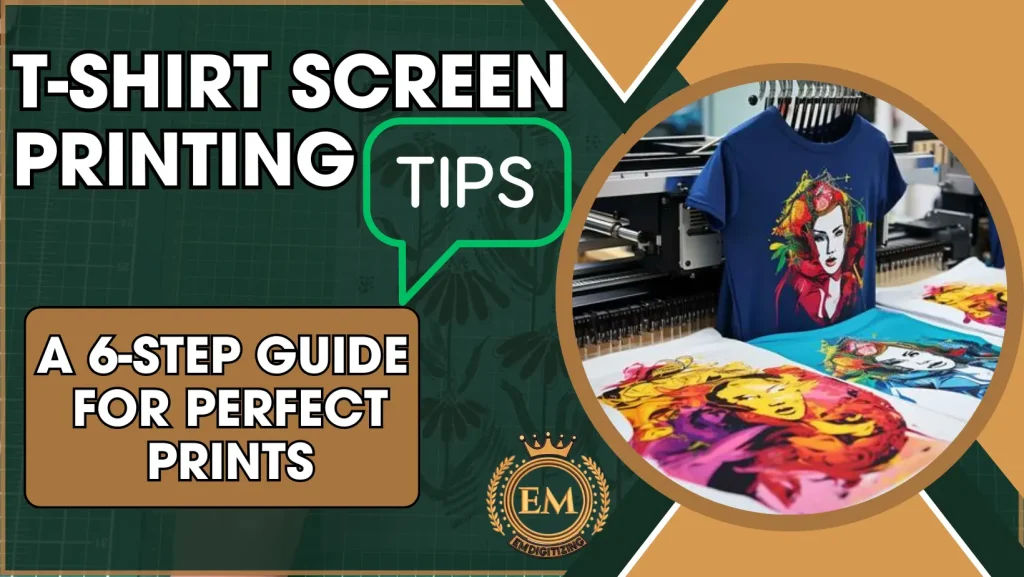
Ce guide complet vous guidera à travers les six étapes essentielles pour obtenir des impressions parfaites à chaque fois..
Conseils pour la sérigraphie de t-shirts: 6-Guide des étapes pour des impressions parfaites
De la sélection du bon équipements et matériaux pour résoudre les problèmes courants, we’;Je couvrirai tout ce que vous devez savoir pour devenir un sérigraphe de t-shirts compétent..
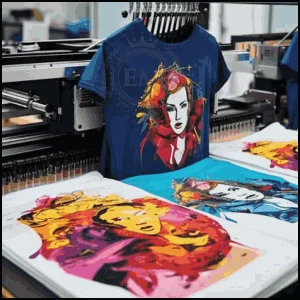
Alors$£€¥789/456*123-0.=+_çàiopjkln,;:! ذ ضِ ئ, let’;Plongez et explorez ensemble le monde fascinant de la sérigraphie sur t-shirts..
Qu'est-ce que la sérigraphie sur t-shirts?
Sérigraphie de tee-shirts est une méthode populaire pour appliquer des motifs sur du tissu à l'aide de sérigraphies et d'encre.. Il s'agit de créer un pochoir sur un écran, à travers lequel l'encre est forcée de créer le motif souhaité sur le t-shirt.

Avantages de la sérigraphie sur t-shirts
La sérigraphie offre plusieurs avantages pour l'impression de t-shirts. Premièrement, it allows for vibrant and long-lasting prints that won’;ne s'estompe pas après quelques lavages.
Deuxièmement, il offre une grande flexibilité en termes de design et d'options de couleurs, vous permettant de donner vie à vos idées créatives.
Dernièrement, la sérigraphie peut être rentable pour de plus grandes quantités, ce qui en fait un excellent choix pour les événements, entreprises, ou à des fins promotionnelles.
Équipements et matériaux essentiels
Équipements et matériels essentiels former l’épine dorsale de toute tâche ou projet, garantir le bon déroulement et l'efficacité des opérations.
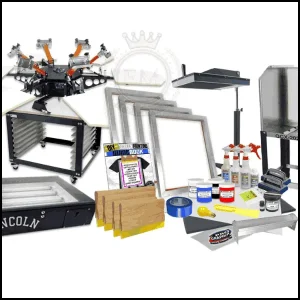
Presse de sérigraphie
Une presse de sérigraphie est l’épine dorsale de votre configuration d’impression. Il maintient l'écran en place et permet une pression constante pendant le processus d'impression.
Écrans et nombre de mailles
Écrans avec diverses mailles les comptes sont utilisés pour créer différents niveaux de détails dans vos impressions. Un nombre de mailles plus élevé est idéal pour les conceptions complexes, tandis que le nombre de mailles inférieur fonctionne mieux pour les caractères gras, conceptions solides.
Encres et additifs
Quand il s'agit d'encres, il existe d'innombrables options disponibles. Les encres à base d'eau sont populaires pour leur toucher doux et leur respect de l'environnement., tandis que les encres plastisol sont connues pour leurs couleurs éclatantes et leur durabilité..

Additifs, tels que des rallonges ou des réducteurs, can help you achieve specific effects or improve the ink’;le flux.
Raclettes et émulsions
Les raclettes sont utilisées pour pousser l'encre à travers l'écran et sur le t-shirt.. Différents duromètres de raclette (dureté) sont disponibles, vous permettant de choisir celui qui convient à vos besoins d'impression.
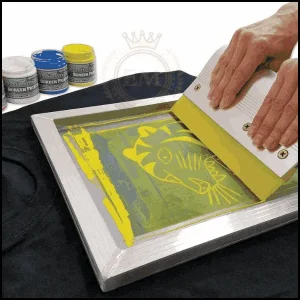
Machines d'émulsion, d'autre part, sont utilisés pour appliquer uniformément l’émulsion sur l’écran, créer le pochoir.
Préparation de l'illustration et du design
La préparation de l'œuvre d'art et du design est une phase critique du processus créatif., où les idées et les concepts sont traduits en représentations visuelles.
Considérations de conception pour la sérigraphie
Quand conception pour la sérigraphie, gardez à l'esprit que chaque couleur nécessite un écran séparé. Par conséquent, it’;Il est important de simplifier votre conception et de minimiser le nombre de couleurs pour éviter la complexité et augmenter l'efficacité..
Vectorisation et préparation de l'œuvre
Pour garantir une impression fluide, transformez votre conception en un format vectoriel et nettoyer toutes les imperfections. Cela aidera à créer des, des lignes nettes et évitent toute surprise inattendue pendant le processus d'impression.
Séparation des couleurs
Pour des designs multicolores, séparation des couleurs est essentiel. Ce processus consiste à séparer chaque couleur en couches individuelles, vous permettant de créer des écrans séparés pour chaque couleur et de les imprimer un par un.

Préparation de l'écran et de l'encre
La préparation de la sérigraphie et de l'encre est une étape essentielle du processus de sérigraphie., où la précision rencontre la créativité.
Choisir le bon écran
La sélection du bon écran est cruciale pour obtenir des impressions exactes et précises. Considérez le nombre de mailles, taille de l'écran, et le matériau du cadre en fonction de votre conception et du résultat souhaité.
Appliquer une émulsion et créer des pochoirs
Enduire votre écran d'émulsion et créer le pochoir est une étape essentielle du processus de sérigraphie.. Follow the manufacturer’;s instructions pour appliquer uniformément l’émulsion, assurer une exposition appropriée et un rinçage complet pour révéler le pochoir souhaité.
Mélanger et préparer l'encre
Mélanger les couleurs d'encre avec précision est essentiel pour obtenir les nuances et les tons souhaités.. Tasses à mélanger, Balance, et Guides de couleurs Pantone peut vous aider à obtenir une correspondance des couleurs cohérente et précise.
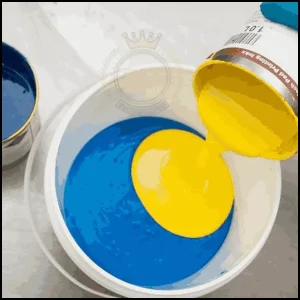
Processus d'impression étape par étape
Le processus d'impression étape par étape est une approche méthodique pour transférer des motifs sur une variété de matériaux., nécessitant une attention aux détails et une maîtrise de la technique.
Configuration de l'écran sur la presse
Avant de plonger dans le monde passionnant de la sérigraphie, vous devez configurer votre écran sur la presse. It’;c'est comme préparer la toile avant de peindre votre chef-d'œuvre.
Assurez-vous que l'écran est bien fixé sur la presse, so it doesn’;Je ne me tortille pas comme une méduse ivre. Un écran stable vous donnera des impressions nettes et nettes.
Alignement de la conception et du plateau
Maintenant que votre écran est prêt, it’;Il est temps d'aligner votre conception avec la platine. Considérez-le comme un jeu de connexion à enjeux élevés, mais avec plus d'encre..
Prenez votre temps pour vous assurer que le motif est centré sur la platine, ou bien vous pourriez vous retrouver avec un T-shirt qui semble avoir été imprimé par un singe aux yeux bandés.
Techniques appropriées d’application de l’encre
Le moment est venu de libérer le Picasso qui sommeille en vous et d'appliquer l'encre.. Don’;ne sois pas avare avec ça, but don’;je ne me déchaîne pas non plus.
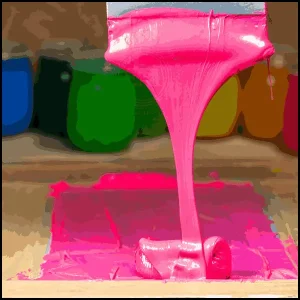
Utilisez juste assez d'encre pour que votre design se démarque, comme un paon exhibant ses plumes. It’;il s'agit de trouver le juste milieu entre trop peu et trop d'encre..
Répartissez-le uniformément sur l'écran, comme un bon criminel.
Durcissement et séchage des chemises imprimées
Toutes nos félicitations, you’;J'ai imprimé avec succès vos chemises! But don’;je ne fais pas encore la fête, parce qu'ils ont besoin de soins tendres et affectueux pour atteindre leur plein potentiel. Faire durcir et sécher les tirages, c'est comme les envoyer dans un luxueux spa.
Follow the instructions for the specific ink you’;réutilisez et donnez à ces chemises un bon traitement thermique pour garantir que les imprimés restent éclatants et durent plus longtemps.
Dépannage des problèmes d'impression courants
Ah, la joie du dépannage. Juste au moment où tu pensais que tout se passait bien, un problème d'impression sauvage apparaît. Don’;je ne panique pas!
Voici quelques problèmes courants que vous pouvez rencontrer et comment les résoudre:
- Saignement d'encre: Si ton encre se répand en dehors des lignes comme un adolescent rebelle, essayez d'utiliser moins de pression lors de l'application de l'encre ou passez à une consistance d'encre plus épaisse. Vous pouvez également essayer d'utiliser un tamis à mailles inférieur pour empêcher l'encre de s'infiltrer..
- Impressions inégales: Si votre design ressemble à un chef-d'œuvre de Picasso (mais pas dans le bon sens), vérifiez à nouveau que votre écran est correctement aligné avec la chemise. Une pression inégale ou un écran mal étiré peut également être à l'origine de ce problème..
- Taches d'encre: Si votre impression semble avoir été attaquée par un monstre à encre espiègle, il peut y avoir un excès d'encre sur l'écran, ou ta raclette pourrait être trop sale. Nettoyez soigneusement les deux et réessayez. And don’;n'oublie pas de te laver les mains après, à moins que tu veuilles te retrouver avec des empreintes digitales tachées d'encre comme un détective en herbe.
EMnumérisation: Expert en numérisation de broderie à votre service
Si vous êtes intéressé par tout type de projet de broderie, alors EMdigitizing est la meilleure option pour vous. Nous offrons numérisation de broderie et des services d'art vectoriel avec un délai d'exécution rapide. Vous pouvez également visiter et consulter notre site Web ainsi que nos meilleurs services.
Nous offrons également un excellent 50% réduction sur tous nos services pour nos nouveaux clients respectés. Nous avons aussi proposer des devis gratuits généré en seulement 5 minutes.
Vous devriez profiter de cette offre à durée limitée et faire passer votre projet de broderie au niveau supérieur avec EMdigitizing.
Si vous avez des questions concernant ce sujet, tu peux leur demander. Merci d'avoir pris le temps de lire cet article.
Questions fréquemment posées:
Il te faut un écran, raclette, encre, émulsion, une pièce sombre, et une source de lumière pour l'exposition. En outre, un espace de travail propre et une zone de séchage pour les chemises finies sont essentiels.
Pre-wash the shirt to remove impurities and ensure it’;qu'il soit complètement sec avant l'impression. Aussi, repasser la chemise pour éliminer les plis qui pourraient affecter la qualité d'impression.
Créez votre conception, préparer et exposer l'écran, appliquer de l'encre à travers l'écran sur la chemise, puis durcir l'encre. Le nettoyage de l'écran après utilisation est crucial pour les futures impressions.
Oui, avec équipement et fournitures de base, vous pouvez commencer la sérigraphie à la maison. La patience et la pratique sont essentielles pour obtenir des résultats professionnels.
